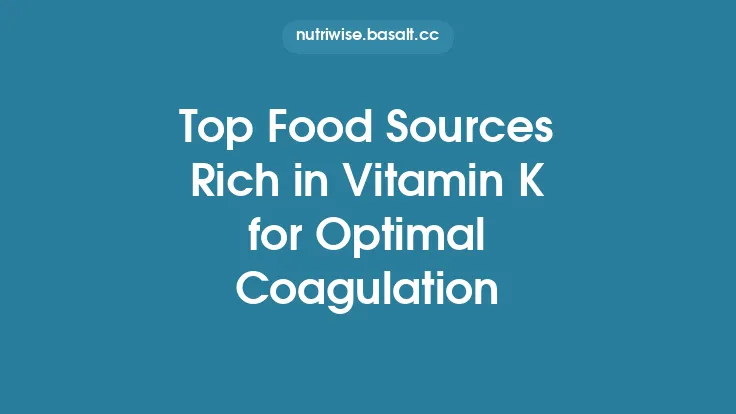Vitamin A is a fat‑soluble micronutrient that plays a pivotal role in maintaining the structural integrity and function of the ocular surface, supporting the phototransduction cascade, and contributing to overall visual performance. While the body can store vitamin A for several months, a steady supply from the diet is essential to keep ocular tissues well‑supplied, especially for individuals with higher visual demands or limited endogenous stores. Below is a comprehensive guide to the foods that deliver vitamin A most efficiently, the biochemical forms in which it appears, and practical strategies for maximizing its availability in everyday meals.
Understanding Vitamin A Forms and Their Relevance to Eye Health
Vitamin A exists primarily in two dietary forms:
| Form | Chemical name | Primary source | Conversion to active vitamin A |
|---|---|---|---|
| Preformed vitamin A | Retinol, retinal, retinyl esters | Animal products (liver, dairy, eggs) | Directly usable; absorbed as retinyl esters and stored in the liver |
| Provitamin A carotenoids | β‑carotene, α‑carotene, β‑cryptoxanthin | Colorful fruits and vegetables | Enzymatically cleaved in the intestinal mucosa to retinal; conversion efficiency varies (≈ 12 µg β‑carotene → 1 µg retinol in average adults) |
For ocular tissues, the active metabolite retinal is incorporated into rhodopsin, the photopigment that initiates the visual signal. Both preformed retinol and carotenoid‑derived retinal can fulfill this requirement, but the bioavailability of each differs markedly. Preformed vitamin A is almost completely absorbed when dietary fat is present, whereas carotenoid conversion is influenced by genetics, gut health, and the food matrix.
Animal‑Based Sources: Retinol‑Rich Foods
| Food | Typical serving size | Retinol activity equivalents (RAE) per serving | Key nutrients that aid absorption |
|---|---|---|---|
| Liver (beef, chicken, pork) | 3 oz (≈ 85 g) | 5,000–7,000 µg RAE | High in protein and fat, providing a natural emulsifying environment |
| Cod liver oil | 1 tsp (≈ 5 ml) | 4,500 µg RAE | Rich in omega‑3 fatty acids that further support ocular surface health |
| Egg yolk | 1 large yolk | 70 µg RAE | Phospholipids in the yolk membrane improve micelle formation |
| Full‑fat dairy (milk, cheese, yogurt) | 1 cup (≈ 240 ml) milk or 1 oz cheese | 30–80 µg RAE | Calcium and casein proteins help stabilize vitamin A in the digestive tract |
| Butter | 1 tbsp (≈ 14 g) | 100 µg RAE | Pure fat source that can be used to boost the absorption of plant carotenoids when combined in a meal |
Practical note: Because liver is exceptionally concentrated, a modest portion (½ oz) can meet or exceed the recommended daily allowance (RDA) for most adults (≈ 900 µg RAE for men, 700 µg RAE for women). However, individuals with certain health conditions (e.g., hyperlipidemia) should moderate intake due to the high saturated fat content.
Plant‑Based Sources: Provitamin A Carotenoids
| Food | Typical serving size | β‑Carotene (µg) per serving | RAE per serving* |
|---|---|---|---|
| Sweet potatoes (baked) | ½ cup (≈ 115 g) | 9,400 | 470 |
| Carrots (raw or cooked) | 1 cup (≈ 128 g) | 8,300 | 415 |
| Butternut squash | ½ cup (≈ 122 g) | 5,500 | 275 |
| Spinach (cooked) | ½ cup (≈ 90 g) | 4,000 | 200 |
| Kale (raw) | 1 cup (≈ 67 g) | 3,200 | 160 |
| Cantaloupe | 1 cup (≈ 160 g) | 2,500 | 125 |
| Red bell pepper | 1 cup (≈ 149 g) | 1,800 | 90 |
| Mango | 1 cup (≈ 165 g) | 1,500 | 75 |
\*RAE (Retinol Activity Equivalents) accounts for the lower conversion efficiency of carotenoids compared with preformed vitamin A.
Carotenoids are lipophilic pigments that dissolve in dietary fat. Their absorption is facilitated by the formation of mixed micelles in the small intestine, a process that requires bile salts and dietary lipids. Consequently, pairing carotenoid‑rich vegetables with a modest amount of fat (e.g., olive oil drizzle, avocado slices, or a handful of nuts) can dramatically increase the amount of vitamin A that reaches circulation.
Enhancing Absorption: The Role of Dietary Fat and Other Nutrients
- Fat quantity and quality – Studies show that as little as 5 g of fat (≈ 1 tsp oil) can maximize carotenoid uptake, while higher fat levels (15–20 g) provide diminishing returns. Monounsaturated fats (olive oil, avocado) and polyunsaturated fats (walnut, flaxseed) are preferable to saturated fats for overall cardiovascular health.
- Bile salts – Adequate bile production is essential for micelle formation. Individuals with malabsorption syndromes (e.g., cholestasis, gallbladder removal) may experience reduced vitamin A absorption and should consider fortified foods or supplements under professional guidance.
- Dietary fiber – Soluble fiber can bind carotenoids and impede absorption, whereas insoluble fiber has a neutral effect. Balancing high‑fiber meals with sufficient fat helps mitigate this interaction.
- Micronutrient synergy – Zinc is a cofactor for the enzyme β‑carotene 15,15′‑dioxygenase, which cleaves β‑carotene into retinal. Foods rich in zinc (e.g., oysters, pumpkin seeds, legumes) can therefore support the conversion of provitamin A to active forms.
Cooking and Preparation Techniques that Preserve Vitamin A
| Technique | Effect on vitamin A content | Recommendations |
|---|---|---|
| Steaming | Minimal loss of water‑soluble nutrients; carotenoids remain largely intact | Ideal for leafy greens and cruciferous vegetables |
| Boiling | Can leach water‑soluble carotenoids into cooking water; up to 30 % loss if water is discarded | Use the cooking liquid in soups or sauces to retain nutrients |
| Roasting / Baking | Heat‑induced softening of cell walls improves carotenoid release; modest oxidation may occur | Roast carrots, sweet potatoes, or squash with a drizzle of oil for optimal bioavailability |
| Sautéing | Combines heat with fat, dramatically enhancing carotenoid absorption | Sauté spinach or kale in olive oil; add a pinch of salt to further break down cell membranes |
| Pureeing / Blending | Mechanical disruption of plant tissue increases surface area, facilitating micelle formation | Blend carrots into soups or smoothies; combine with a fat source for best results |
| Freezing | Short‑term freezing preserves carotenoid content; long‑term storage may cause slight degradation | Freeze berries, mango, or chopped vegetables in airtight containers; thaw quickly before use |
Heat stability note: Retinol is relatively heat‑stable, but prolonged high temperatures can cause isomerization to less active forms. Therefore, gentle cooking methods are preferred for animal‑based sources.
Seasonal and Regional Variations in Vitamin A‑Rich Foods
- Spring/Summer (Northern Hemisphere): Abundant fresh berries (mango, cantaloupe), leafy greens (spinach, kale), and early‑season carrots. Farmers’ markets often feature heirloom varieties with higher carotenoid concentrations.
- Fall/Winter: Root vegetables (sweet potatoes, carrots, butternut squash) become staples. Canned pumpkin and winter squash retain most of their carotenoid content when processed without excessive heat.
- Tropical regions: Papaya, mango, and ripe tomatoes provide substantial β‑carotene. Coconut oil, a prevalent cooking fat, serves as an excellent medium for carotenoid absorption.
- Coastal and pastoral areas: Access to fresh fish liver oils, marine mammals, and dairy products offers natural sources of preformed vitamin A.
Adapting meal plans to seasonal availability not only enhances nutrient density but also supports sustainable food practices.
Incorporating Vitamin A into Daily Meals: Sample Menus and Recipes
Breakfast
- Spinach‑Feta Omelet – 2 eggs cooked with ½ cup fresh spinach, ¼ cup feta, and 1 tsp olive oil. Provides ~150 µg RAE from egg yolk and ~40 µg RAE from spinach.
- Mango‑Greek Yogurt Parfait – ½ cup plain full‑fat Greek yogurt layered with ½ cup diced mango and a sprinkle of chopped walnuts. Adds ~75 µg RAE and healthy fats.
Mid‑Morning Snack
- Carrot Sticks with Hummus – 1 cup raw carrot sticks (≈ 415 µg RAE) dipped in 2 tbsp hummus (source of zinc).
Lunch
- Grilled Salmon Salad – 4 oz grilled salmon (source of omega‑3s) atop mixed greens, ½ cup roasted butternut squash, ¼ avocado, and a dressing of 1 tbsp olive oil and lemon juice. The squash contributes ~275 µg RAE; the oil ensures optimal carotenoid uptake.
Afternoon Snack
- Cheese and Apple Slices – 1 oz cheddar cheese (≈ 80 µg RAE) paired with a crisp apple for fiber.
Dinner
- Beef Liver Paté – 2 oz sautéed beef liver with onions, butter, and a splash of brandy, served on whole‑grain toast. Provides > 2,000 µg RAE in a single serving.
- Steamed Broccoli – ½ cup (≈ 30 µg RAE) as a side, drizzled with melted butter.
Evening Snack (optional)
- Warm Milk with a Dash of Cinnamon – 1 cup full‑fat milk (≈ 30 µg RAE) promotes relaxation and adds a modest vitamin A boost before bedtime.
These examples illustrate how a balanced combination of animal and plant sources, paired with appropriate fats, can comfortably meet or exceed daily vitamin A needs without excessive reliance on any single food.
Special Considerations for Different Life Stages and Dietary Patterns
| Population | Recommended intake (RAE) | Preferred sources | Practical tips |
|---|---|---|---|
| Pregnant & lactating women | 770 µg (pregnancy), 1,300 µg (lactation) | Liver (limited to ≤ ½ oz/week), fortified dairy, β‑carotene vegetables | Emphasize fortified cereals and dairy; avoid excessive liver due to preformed vitamin A excess risk |
| Infants (6–12 mo) | 300 µg | Pureed carrots, sweet potatoes, fortified infant formula | Introduce single‑ingredient purees; combine with breast milk or formula for fat |
| Vegetarians | 700–900 µg | Carotenoid‑rich produce, eggs, dairy, fortified plant milks | Pair carotenoid foods with nuts, seeds, or oils; consider fortified foods for retinol |
| Vegans | 700–900 µg | Fortified plant milks, algae oil, orange‑colored fruits/veggies | Use algae‑derived DHA/EPA supplements that also contain retinol analogs; ensure adequate zinc intake |
| Elderly | 900 µg (men), 700 µg (women) | Soft‑cooked vegetables, fish liver oils, dairy | Opt for softer textures to aid chewing; monitor for interactions with medications that affect fat absorption |
Storage, Shelf Life, and Food Safety
- Fresh produce: Store carrots, sweet potatoes, and winter squash in a cool, dark pantry (10–15 °C) to minimize carotenoid degradation. Leafy greens should be kept in the refrigerator’s crisper drawer, wrapped in a damp paper towel to retain moisture.
- Canned and frozen items: Vitamin A is relatively stable during canning and freezing. However, avoid prolonged exposure to high temperatures after opening; transfer leftovers to airtight containers and refrigerate promptly.
- Animal liver: Keep refrigerated and consume within 2–3 days of purchase, or freeze in portioned bags for up to 3 months. Thaw slowly in the refrigerator to preserve nutrient integrity.
- Oils: Light‑sensitive carotenoids in oil‑based dressings can oxidize. Store oils in dark glass bottles, away from heat, and use within 6 months of opening.
Practical Tips for Monitoring and Maintaining Adequate Intake
- Food‑frequency tracking: Use a simple weekly log to note servings of vitamin A‑rich foods. Aim for at least three servings of carotenoid vegetables and two servings of preformed vitamin A sources per week.
- Visual cues: Bright orange, deep red, and dark green produce are typically high in carotenoids. Incorporate a “rainbow plate” at each meal to naturally increase intake.
- Mindful pairing: Add a teaspoon of oil, a few slices of avocado, or a handful of nuts to salads and cooked vegetables to boost absorption without excessive calories.
- Fortified products: When dietary patterns limit natural sources, choose fortified plant milks, cereals, or spreads that list “vitamin A (as retinyl acetate)” on the label.
- Professional guidance: Individuals with chronic liver disease, malabsorption disorders, or those on weight‑loss regimens should consult a registered dietitian or healthcare provider to tailor vitamin A intake safely.
By integrating a variety of vitamin A‑rich foods, respecting the biochemical nuances of absorption, and applying culinary strategies that preserve nutrient potency, you can sustain optimal ocular function throughout the lifespan. The approach outlined here emphasizes flexibility, cultural relevance, and evidence‑based nutrition, ensuring that the eye’s visual machinery receives the micronutrient support it needs—day after day.





